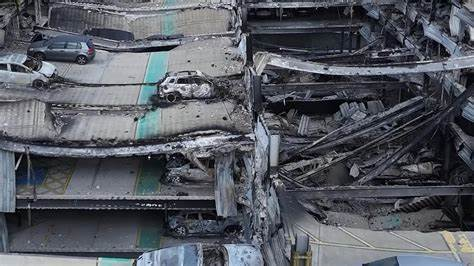In late October 2022, a devastating fire broke out at Luton Airport’s Terminal 2 car park, causing widespread chaos and significant damage. The fire, which engulfed hundreds of vehicles and led to a partial collapse of the car park, not only disrupted travel for thousands of passengers but also raised numerous safety and logistical questions. In this article, we explore the details surrounding the fire, its cause, the aftermath, and the ongoing impact on the airport and its operations.
The Cause of the Fire
The Luton Airport car park fire, which started around 9 PM on October 11, 2022, was later determined to have been triggered by a diesel car. Although initial speculation had linked the fire to electric vehicles, which have been involved in other high-profile fires, Bedfordshire Fire and Rescue clarified that the blaze was initiated by a diesel-powered vehicle. This information was confirmed by the chief fire officer, Andrew Hopkinson, who emphasized that electric vehicles were not responsible for the incident. The fire spread rapidly through the third floor of the newly built car park, damaging up to 1,500 vehicles. The intensity of the blaze led to a partial collapse of the structure, complicating firefighting efforts and causing additional safety concerns.
The Firefighting Efforts
The firefighting response to the Luton Airport fire was swift and massive, with over 100 firefighters battling the flames through the night. Crews from nearby towns and cities were called in to assist, including teams from Dunstable, Harpenden, and Leighton Buzzard. The fire was so intense that, within minutes of the first response, the teams had to evacuate from the car park due to the extreme conditions and structural concerns.
As the fire continued to spread, firefighters adopted a defensive approach to contain the blaze to the third floor, preventing it from spreading to other buildings on the airport campus, including the nearby DART Station and Car Park 1. Throughout the night, the fire spread to all floors of the car park, causing further collapses and spreading destruction.
Impact on Passengers and Flights
The fire disrupted thousands of travelers at Luton Airport. Between 40,000 and 50,000 passengers were affected, with 273 flights either canceled, diverted, or delayed due to the damage to the car park and the fire response. Many passengers were forced to sleep on the floor in the terminal as nearby hotels were fully booked.
In addition to the flight disruptions, the fire caused severe delays, with some flights resuming only 18 hours later. For instance, a Ryanair flight to Cork, which was originally scheduled to depart at 1 PM on October 12, was delayed until 3:30 PM. The delays caused considerable inconvenience, especially for passengers who were traveling on tight schedules.
The Aftermath: Recovery and Safety Measures
The immediate aftermath of the fire saw the airport’s car park out of service, and authorities worked to assess the damage and ensure the safety of the remaining infrastructure. While no fatalities occurred, five people, including four firefighters and an airport official, were treated for smoke inhalation.
In the longer term, the fire prompted a review of safety protocols at Luton Airport, especially concerning the design of parking facilities. One key issue identified was the lack of sprinkler systems in the car park, which may have helped contain the fire more quickly. Following the incident, airport officials discussed the possibility of retrofitting sprinklers in existing parking structures. Additionally, airport management and the fire services have been in talks about ensuring that future parking structures are designed with enhanced fire safety measures, including better fire containment and suppression systems.
Lessons Learned: Car Park Safety and Fire Prevention
The Luton Airport fire highlights several critical areas of concern for both passengers and facility managers. First and foremost is the importance of fire safety in multi-story car parks, which can become deadly fire traps when flames spread rapidly across multiple floors. The lack of sprinkler systems in the Luton car park is now seen as a key safety failure, and this may influence regulations for parking garages across the UK.
Another major takeaway is the need for clearer safety protocols for responding to large-scale fires in crowded areas. The fire response, while effective, exposed vulnerabilities in managing such intense fires in a confined space, leading to ongoing discussions about improving training and equipment for emergency services.
The Ongoing Impact of the Fire
The Luton Airport car park fire was a wake-up call for both the aviation industry and emergency response teams. While the immediate impact on travel was significant, the lessons learned from this incident are being used to improve safety standards for the future. The airport’s efforts to rebuild and improve its infrastructure, along with the firefighting agencies’ focus on refining emergency protocols, will likely help prevent similar disasters in the future. Through the fire is a thing of the past, the questions it raised about car park safety, the role of electric vehicles in fires, and the effectiveness of firefighting measures will likely remain a topic of debate for some time.
FAQs
What happened during the Luton Airport car park fire?
In October 2024, a massive fire broke out in the multi-story car park at Luton Airport, damaging hundreds of cars. The blaze rapidly spread across multiple floors of the facility, forcing emergency responders to take extreme measures. Firefighters battled the intense heat and structural instability, while airport operations were temporarily disrupted.
What caused the fire in the Luton Airport car park?
The exact cause of the fire is still under investigation, but early reports suggest the fire was triggered in a section of the car park where a large number of electric vehicles were parked. The blaze spread quickly due to the combination of high temperatures and the materials of the vehicles involved.
How did the fire spread so quickly?
The fire escalated rapidly, reaching up to 80% of the third floor within the first 30 minutes. Emergency crews initially attempted to contain it internally but were forced to evacuate as temperatures soared and the building’s structural integrity began to fail. By midnight, the fire had spread to all floors, collapsing parts of the car park and making firefighting efforts even more challenging.
How long did it take to contain the fire?
The fire was not fully under control until the early hours of the next morning. Due to the scale of the damage and the structural collapse of the building, efforts focused on preventing the fire from spreading to nearby areas like the DART station and other parts of the airport.
In Summary
The fire at Luton Airport’s multi-story car park in October 2024 was a devastating event, causing significant damage and raising concerns about fire safety, particularly in facilities housing electric vehicles. Emergency responders worked tirelessly through extreme conditions, with the fire quickly spreading across multiple floors of the car park. While there were injuries, including several firefighters and an airport worker, no fatalities were reported.
To read more, Click Here .








